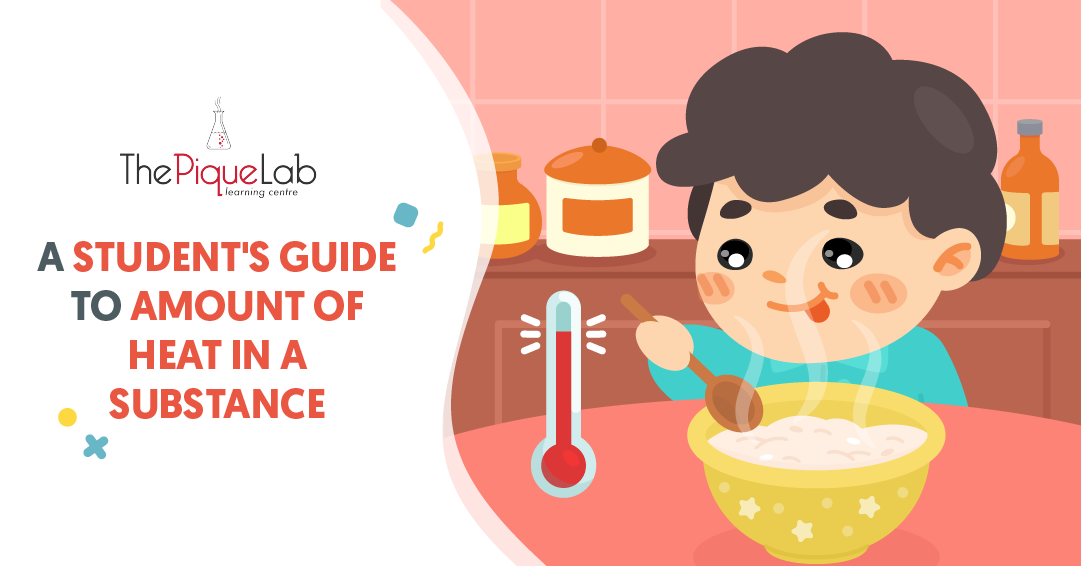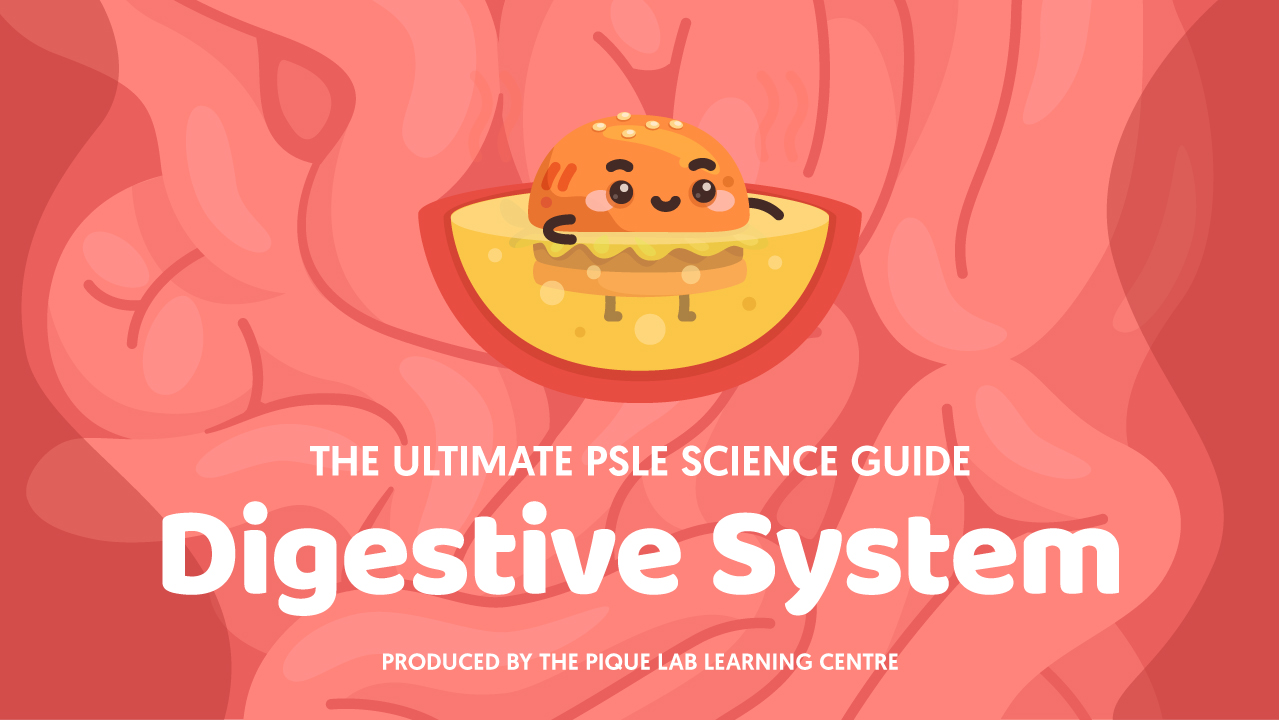Heat Energy is a Primary 4 topic many students struggle with. With so many concepts to keep in mind and such a variety of creative questions that examiners could possibly test to check your understanding and application of Heat Energy concepts, it’s no wonder that even the Primary 6 students face difficulty with this topic!

As such, I’m back with another article on Heat Energy today, specifically on the concept of ‘amount of heat’ – a concept that many students find challenging to apply to questions. I will share some of my tips in this article to help you visualise this concept better, so do read on!
Read Also:
Factors Affecting Amount Of Heat
As most students understand that heat energy makes objects hot, they can easily identify that an object with a higher temperature (hotter) possesses more heat than an object (of the same volume) with a lower temperature.
However, does this then mean that two objects of the same temperature definitely have the same amount of heat? Contrary to what many students think, the answer is no!
Instead, the amount of heat energy in an object depends on its volume as well. When comparing two objects of the same temperature, the object with a larger volume has more heat than the object with a smaller volume.
Hence, you can remember the factors affecting the amount of heat energy possessed by a substance as ‘TV’.
No, not television. 📺
🔥 ‘TV’ as in the two factors affecting the amount of heat energy in a substance:
- Temperature
- Volume
As a matter of fact, we can understand how the amount of heat possessed by a substance is affected by its temperature and its volume when we pay more attention to certain situations around us, especially when food is involved. Can you think of any examples?
If you’re having some difficulties recalling how the concept of ‘amount of heat’ is applied in our daily lives, read on to see four examples that show how the amount of heat is affected by both temperature and volume!
Applying Concept Of ‘Amount Of Heat’ To Our Everyday Lives
After you have read the observation for each scenario, try thinking of the reason for the observation made before scrolling to see the explanation!
🍜 Cooking Cup Noodles (Different Temperatures, Same Volume)

Observation: After 3 minutes, the noodles in the water at 90 ˚C are more cooked than the noodles in the water at 40 ˚C.
Explanation: The water at 90 ˚C is at a higher temperature and has more heat. Thus, the noodles can gain more heat from the 90 ˚C water to be more cooked.
🥚 Cooking Half-Boiled Eggs (Same Temperature, Different Volumes)

Observation: After 7 minutes, each egg is cracked into a dish and observed. The half-boiled egg that was cooked in 250 ml of water still has colourless uncooked portions, while the half-boiled egg that was cooked in 500 ml of water has no uncooked portions.
Explanation: The 500 ml of water has a greater volume than the 250 ml of water. Thus, the 500 ml of water has more heat, allowing the egg to gain more heat from the water to be more cooked.
🍲 Time Taken To Boil Soup (Same Temperature, Different Volumes)

Observation: The soup in the pot takes a longer time to come to a boil as compared to the soup in the saucepan.
Explanation: The soup in the pot has a larger volume. Thus, the soup needs to gain more heat from the fire to increase in temperature until it reaches its boiling point, causing it to take a longer time to come to a boil.
🥣 Time Taken For Porridge To Cool (Same Temperature, Different Volumes)

Observation: The porridge in the larger bowl takes a longer time to cool to room temperature as compared to the porridge in the smaller bowl.
Explanation: The porridge in the larger bowl has a larger volume. Thus, the porridge needs to lose more heat to the cooler surrounding air to achieve the same decrease in temperature, causing it to take a longer time to cool to room temperature.
Key Takeaways
What can we understand from the above scenarios?
The key takeaway is Ms. Eunice was famished at the time of writing this article! 🤣
Jokes aside, the key takeaways from the above examples are:
- Comparing two objects of the same volume, the object with a higher temperature has more heat.
- Comparing two objects of the same temperature, the object with a larger volume has more heat.
- Comparing two objects of the same temperature, the object with a larger volume needs to gain more heat to achieve the same increase in temperature.
- Comparing two objects of the same temperature, the object with a larger volume needs to lose more heat to achieve the same decrease in temperature.
As shown by point 1 of the key takeaways above, the amount of heat in an object depends on its temperature.
Additionally, points 2 to 4 of the above key takeaways show that the amount of heat in an object depends on its volume as well!
However, if points 2 to 4 above are unfortunately still a little puzzling for you and you are unable to visualise how exactly the volume of the substance affects the amount of heat in an object, my dear reader, not to worry. I have another way to help you to understand, especially if you are more numerically inclined:
Using Numbers To Explain Point 2
💭 Recall the key takeaway from the 🥚 half-boiled eggs scenario:
Comparing two objects of the same temperature, the object with a larger volume has more heat.
If the following object, Object X at 10 ˚C, has 10 units (u) of heat energy,

Object X: 10˚C
then Object Y of the same temperature, which has four times the volume of Object X, would have 40 u of heat energy, which is four times the amount of heat energy possessed by Object X (4 x 10 u).

Object Y: 10 ˚C
Using Numbers To Explain Point 3
💭 Recall the key takeaway from the 🍲 boiling soup scenario:
Comparing two objects of the same temperature, the object with a larger volume needs to gain more heat to achieve the same increase in temperature.
Let’s say that for Object X to increase in temperature by 1 ˚C, Object X needs to gain 1 u of heat.
Object X: 10 ˚C + 1 ˚C = 11 ˚C
However, since Object Y has four times the volume of Object X, Object Y would have to gain 4 u of heat energy, which is four times the amount of heat energy gained by Object X (4 x 1 u), in order to increase in temperature by 1 ˚C.

Object Y: 10 ˚C + 1 ˚C = 11 ˚C
Using Numbers To Explain Point 4
💭 Recall the key takeaway from the 🥣 porridge scenario:
Comparing two objects of the same temperature, the object with a larger volume needs to lose more heat to achieve the same decrease in temperature.
Similarly, for Object X to decrease in temperature by 1 ˚C, Object X need only lose 1 u of heat.

Object X: 10 ˚C – 1 ˚C = 9 ˚C
Based on the patterns you can find above, how much heat do you think Object Y would have to lose in order to decrease in temperature by 1 ˚C? Object Y would have to lose 4 u of heat, which is four times the heat energy lost by Object X (4 x 1 u)! This is due to its volume being four times that of Object X.

Object Y: 10 ˚C – 1 ˚C = 9 ˚C
I hope that the above visuals have made understanding points 2 to 4 of the key takeaways easier for you.
Now that we have a better grasp on the concept of ‘amount of heat’, let’s apply what we have learnt to a tougher question taken from a past-year P6 examination paper.
Let’s Take A Look At This Question

Source: Rosyth School (ROSYTH) – 2018 P6 SA1 Examination Paper [Q20]
Thought Process
Whenever there are two or more set-ups in a question, I remind my students to spot the difference(s) between the set-ups. This is key to shaping our thought process.
Have you spotted the two differences in the set-ups yet? Here are what I have noticed:
- The temperature of the water in the beakers is different: 20 ˚C VS 80 ˚C
- The volume of the water in the beakers is different: 50 ml VS 100 ml
Next, we take note of what the question wants us to answer: we need to identify the beaker of water that would show the greatest rise in the temperature.
How would the water be able to increase in temperature? The water would have to gain heat from the 80 ˚C metal block.
💭 Recall the property of heat:
Heat travels from a warmer region to a cooler region.
What does this mean? This means that…
… warmer objects lose heat to cooler objects.
… cooler objects gain heat from warmer objects.
… there is no heat transfer between two objects of the same temperature.
This means that only water that is cooler than the 80 ˚C metal block would be able to gain heat from the warmer metal block and increase in temperature.
Let us take a look once more at the temperature of the four beakers of water in the question.

We notice that the water in Beakers A and D is at 80 ˚C, which is the same temperature as the metal block. Since there is no temperature difference between the 80 ˚C water and the 80 ˚C metal block, would the water be able to gain heat from the metal block? No, there would not be any heat transfer between the water and the metal block. This means that the water in Beakers A and D will not increase in temperature.
What about the water in Beakers B and C – can they gain heat from the metal block? Yes, they can! The 20 ˚C water in Beakers B and C is cooler than the 80 ˚C metal block, allowing the cooler water to gain heat from the warmer metal block and increase in temperature.
Remember what the question was?
“In which beaker would the water show the greatest rise in temperature?”
With this, we can eliminate Beakers A and D from the running since the water in these two beakers would not even show a rise in temperature. Our only two choices left are Beakers B and C.
Now, here is where some students are baffled.
“What to do next?” they wonder. “The temperature of the water in both Beakers B and C is 20 ˚C. The temperature of the metal block in both beakers is 80 ˚C. Since the temperature difference between the metal block and the water is the same for both beakers, the water should gain heat from the metal blocks at the same rate! The water in both beakers should increase in temperature by the same amount!” they think. “There’s no right answer!” they conclude as they panic. 🤯
While it is true that the cooler water in both Beakers B and C would gain heat from the warmer metal block at the same rate due to the temperature difference between the water and the metal blocks being the same, there’s one mistake in the above thought process.
⭐️ Remember, my dear readers: spot the difference between the set-ups.
The difference will be the key to pointing your thought process in the right direction.
Look at Beakers B and C again. What’s the difference between the water in these two set-ups?

That’s right – the volume of the water is different! How does this affect the rate of heat transfer between the warmer metal block and the cooler water?
It doesn’t!
These students are right in thinking that the water should gain heat from the metal blocks at the same rate due to the temperature difference between the water and the metal block being the same. However, the water in both beakers would not increase in temperature by the same amount.
Instead, as the different volumes of water affect the amount of heat needed for the water to achieve the same increase in temperature, one beaker of water would show a greater rise in temperature than the other. Hence, they now need to apply their understanding of the concept of ‘amount of heat’.
💭 Recall the key takeaway from the 🥣 boiling soup scenario:
Comparing two objects of the same temperature, the object with a larger volume needs to gain more heat to achieve the same increase in temperature.
Based on the above, can you tell me if the water in Beaker B or Beaker C would need to gain less heat in order to achieve the same increase in temperature?
The smaller volume of water in Beaker B would need to gain less heat than the water in Beaker C to achieve the same increase in temperature. Thus, after the water in Beakers B and C gain the same amount of heat from the warmer metal blocks, the water in Beaker B would have a greater rise in temperature and would be at a higher temperature.
Once again, here are some hypothetical numbers for those of you who are more numerically inclined:

From the above, we can see the water in Beaker B would show a greater rise in temperature than the water in Beaker C.
Now some of you might be thinking “The above explanations are clear and the math is logical, but what about the students who have difficulty working with numbers during examinations?”
Fret not. I have another method of arriving at the answer that my students have found helpful – the ‘exaggeration method’. ⭐️
⭐️ What is the ‘Exaggeration Method’?
Here’s how this visualisation method works:
Firstly, note the difference in the volume of the objects we are to compare. In this case, the water in Beaker B has a smaller volume (50 ml) while the water in Beaker C has a larger volume (100 ml).
Next, exaggerate those volumes. Imagine the smaller volume of water as an object with a small volume, like a mug or a bowl of water. Imagine the larger volume of water as an object with a huge volume, like a swimming pool or the sea.
Now, imagine what dropping the hot 80 ˚C metal block into those exaggerated volumes of water does to the temperature of the water. Would the temperature of the water in the bowl increase more, or would the temperature of the water in the swimming pool increase more?


The answer is: the temperature of the water in the bowl increases more! As a matter of fact, the temperature of the water in the bowl (smaller volume of water) would increase rapidly, while the temperature of the water in the swimming pool (larger volume of water) would hardly see an increase.
We can now link the above visuals back to Beakers B and C and pick an answer to the question.

In case you have forgotten, this was the question:
“In which beaker would the water show the greatest rise in temperature?”
With our understanding from the ‘exaggeration method’, we have arrived at the answer – Beaker B’s water would show the greatest rise in the temperature.
No matter if you use a scientific explanation, some hypothetical numbers, or the exaggeration method to think through this question, you will still arrive at the answer, which is option 2!
Suggested Answer
(2) Beaker B.
Moving Forward
I hope that you have enjoyed reading this article and that this article has helped you to gain a better understanding of the concept of ‘amount of heat’, as well as of some common everyday scenarios that involve the application of this concept.
I also hope that you now find yourself better equipped to solve the tougher ‘amount of heat’ questions, having seen the various methods I used to analyse the ‘amount of heat’ question in this article.
Read our other Heat Energy articles and continue to keep a lookout for our new articles!

If you like our methodology, we've some upcoming workshops:








